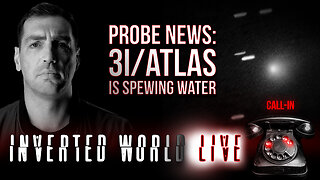Premium Only Content

Class VIII Course #10 Assists (Warning! OT III Data)
Warning! OT III Data Included.
Class VIII Course – Lecture 10: “Assists”
Delivered October 3, AD 18 (1968)
Summary
Hubbard opens by mentioning that the Class VIII auditors are being publicized internationally, emphasizing the Sea Org’s efficiency and the importance of demonstrating what standard tech can accomplish. He then begins the lecture proper, devoted to the exact procedures for giving assists — specialized applications of auditing intended to help a preclear (PC) recover from injury, illness, or acute physical distress.
Contact Assists and Touch Assists
The first part of the lecture gives precise definitions and methods for two primary kinds of assists:
Contact Assist:
The auditor takes the person to the exact physical location of the incident or object that caused the injury and has him touch it repeatedly until the pain or “somatic” blows through. Hubbard stresses that this should only be done if the object still exists; if it does, it’s the preferred method. The purpose is to restore the PC’s communication with the physical universe at the point of impact.
Touch Assist:
When the contact site isn’t available, the auditor performs a touch assist by gently touching areas of the body—usually along nerve channels—having the PC acknowledge each touch. The procedure restores communication flow in the body, especially when injury shock has interrupted it. Hubbard explains that nerve impulses travel at about ten feet per second and that pain from a head injury can reverberate through the spinal column. Therefore, he advises touching from the head to the extremities and working bilaterally—right and left sides of the body—to discharge the shock wave symmetrically.
He emphasizes gradients: never force the PC, but approach the painful or resisted area gradually. Overwhelming the PC would worsen the condition. Similarly, if bleeding or a fracture is present, first handle the emergency (such as applying a tourniquet) before performing an assist.
Handling the Sick or Injured PC
Hubbard then broadens the subject to sick PCs—those suffering from sudden, acute physical or psychosomatic distress. He warns that in such cases, one should not expect to “fly the needle” before a major process because the person is already locked in the major incident itself. The auditor must apply standard tech gently and precisely, maintaining perfect TRs and ARC.
He describes instances where PCs suddenly collapse or feel they are dying, phenomena he attributes to the restimulation of incidents not properly handled on OT III. Such restimulation can manifest as real agony or severe illness, even resembling food poisoning or infection. According to Hubbard, conventional treatment will often fail unless the underlying mental or spiritual cause is addressed. When the auditor corrects the case spiritually, even medical treatment begins to work better.
The Assessment for a Sudden Illness
When a person becomes acutely ill or distressed, Hubbard advises making a rapid assessment of possible causes:
Bad food or toxins
A reactivated engram
A restimulated body thetan or cluster
Drug influence
Once the most likely cause is identified by read on the E-meter, the auditor proceeds accordingly. If it’s a body thetan or cluster, the auditor applies standard OT III procedure (referred to as “doing a Milazzo” — finding the mutual engram and dating it).
⚠️ WARNING: OT III MATERIAL INCLUDED BELOW
Hubbard explains that a body thetan or group of them may be sitting in a mutual engram that must be precisely dated and identified. When dated correctly, the auditor runs the incident on the body thetans until they “blow” (separate from the being). He notes that often dozens may leave at once, but not all—some remain, and those must later be individually handled with Incident I running.
He then gives context for these incidents:
Incident I: a brief, early implant involving a bright flash and thunderous impact, designed to shock and fixate beings.
Incident II (OT III Incident): a vast catastrophe from 75 million years ago involving the ruler Xenu, a galactic confederation of 76 planets, and the mass implanting of captured beings on Earth (Teegeeack).
According to Hubbard, this event involved atomic explosions in volcanoes, mass deaths, and the subsequent implantation of all thetans with pictures and symbols—later dramatized in human civilization, religion, and art.
He describes how modern imagery such as the cross, volcanoes, and certain architectural forms derive from this implanted material. The incident, he says, also introduced ideas of sin, sickness, death, and lifespan limitation.
He states that the Roman Catholic crucifix, for instance, comes from symbols seen in R6 (the implant sequence from Incident II), and that early Christianity appropriated fragments of this. He asserts that mankind’s tendency toward disease, aging, and amnesia stems from these implants.
Hubbard warns auditors to understand that many PCs are still under the influence of these patterns and that auditing must proceed with precision and compassion.
Return to the Theme of Assists
After explaining the spiritual background, Hubbard returns to the technical use of assists. He notes that when an auditor handles such a case correctly—gently identifying the source and cooling it down—the PC stabilizes and “lives to be audited another day.”
He stresses that even though these situations involve extraordinary phenomena, standard tech must always be used. The auditor’s discipline and ethics are paramount: no forcing, no verbal overwhelm, and no deviation from standard auditing form.
Later Notes on Overruns and Standard Tech
Hubbard closes the lecture with instruction on avoiding errors when dealing with higher-level cases (OT III and above). He explains that an “overrun on III” usually means that a body thetan was overrun, not that the entire process was. The solution is to rehabilitate the specific incident for that being, not to invalidate the PC’s entire progress.
He emphasizes again that all cases can be resolved with standard technology, and that so-called “strange cases” are the result of false reports or nonstandard auditing. He warns that this is how “squirreling” begins—by inventing new techniques when the auditor has failed to apply standard ones correctly.
-
 1:34:23
1:34:23
FreshandFit
13 hours agoThe Simp Economy is Here To Stay
147K13 -
 19:35
19:35
Real Estate
14 days ago $2.07 earnedMargin Debt HITS DANGEROUS NEW LEVEL: Your House WILL BE TAKEN
11.4K3 -
 4:03:48
4:03:48
Alex Zedra
9 hours agoLIVE! Battlefield 6
48.4K2 -
 2:03:15
2:03:15
Inverted World Live
10 hours agoProbe News: 3I Atlas is Spewing Water | Ep. 125
122K26 -
 3:02:07
3:02:07
TimcastIRL
10 hours agoTrump Admin CATCHES Illegal Immigrant POLICE OFFICER, Democrats ARM Illegal In Chicago | Timcast IRL
249K146 -
 4:39:39
4:39:39
SpartakusLIVE
10 hours agoNEW Mode - ZOMBIES || LAST Stream from CREATOR HOUSE
61.5K7 -
 3:36:25
3:36:25
The Charlie Kirk Show
11 hours agoTHOUGHTCRIME Ep. 101 The New York City Communist Debate? MAGA vs Mamdani? Medal of Freedom Reactions
163K71 -
 2:14:47
2:14:47
Flyover Conservatives
1 day agoSatan’s Agenda vs. God’s Timeline: Witchcraft, Israel, and the Assassination of Charlie Kirk w/ Robin D. Bullock and Amanda Grace | FOC Show
63.8K16 -
 3:14:57
3:14:57
PandaSub2000
5 days agoBye Sweet Carole | MIDNIGHT ADVENTURE CLUB (Original Live Version)
46.5K1 -
 1:22:51
1:22:51
Glenn Greenwald
13 hours agoThe Irony of John Bolton's Classified Docs Indictment; Prominent Dems Now Stutter When Asked About AIPAC; Celebs in Saudi Arabia Controversy: What Does it Reveal? | SYSTEM UPDATE #532
108K65